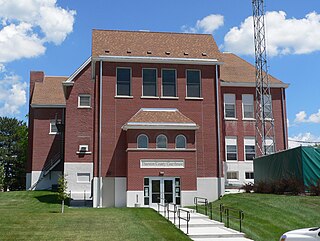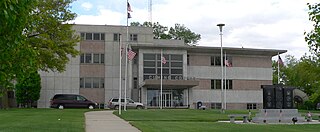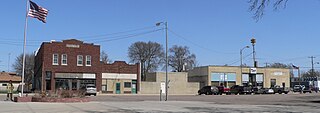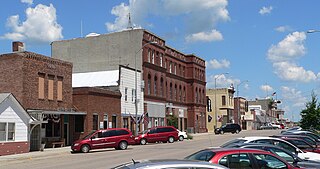
Thurston County is a county in the U.S. state of Nebraska. As of the 2020 United States Census, the population was 6,773. Its county seat is Pender.

Dodge County is a county in the U.S. state of Nebraska. As of the 2020 United States Census, the population was 37,167. Its county seat is Fremont. The county was formed in 1855 and named after Iowa Senator Augustus C. Dodge.

Dakota County is a county in the U.S. state of Nebraska. As of the 2020 United States Census, the population was 21,582. Its county seat is Dakota City.

Cuming County is a county in the U.S. state of Nebraska. As of the 2020 United States Census, the population was 9,013. Its county seat is West Point.

NelighNEE-lee is a city and county seat in Antelope County, Nebraska, United States. The population was 1,599 at the 2010 census.

Tekamah is a city in Burt County, Nebraska, United States. The population was 1,736 at the 2010 census. It is the county seat of Burt County.

Exeter is a village in Fillmore County, Nebraska, United States. The population was 516 at the 2020 census.

Norfolk is a city in Madison County, Nebraska, United States, 113 miles northwest of Omaha and 83 miles west of Sioux City at the intersection of U.S. Routes 81 and 275. The population was 24,210 at the 2010 census, making it the ninth-most populous city in Nebraska. It is the principal city of the Norfolk Micropolitan Statistical Area.

Brownville is a village in Nemaha County, Nebraska, United States. The population was 142 at the 2020 census.

Otoe is a village in north central Otoe County, Nebraska, United States. The population was 161 at the 2020 census.

Duncan is a village in Platte County, Nebraska, United States. The population was 351 at the 2010 census.

Morrill is a village located in Scotts Bluff County, Nebraska, United States, in the western Panhandle of the state. Morrill is part of the Scottsbluff, Nebraska Micropolitan Statistical Area. The population was 921 at the 2010 census.

Garland, formerly known as Germantown, is a village in Seward County, Nebraska, United States. It is part of the Lincoln, Nebraska Metropolitan Statistical Area. The population was 216 at the 2010 census.

Seneca is an unincorporated community in Thomas County, Nebraska in the Great Plains region of the United States. The population was 33 at the 2010 census.

Pender is a village in and the county seat of Thurston County, Nebraska, United States. On March 22, 2016, the United States Supreme Court resolved a disagreement as to whether Pender is located on the Omaha Indian Reservation, holding unanimously that "the disputed land is within the reservation’s boundaries." The predominantly European-American population was 1,115 at the 2020 census.

Rosalie is a village in Thurston County, Nebraska, United States, within the boundaries of the Omaha Indian Reservation. The population was 160 at the 2010 census.

Blair is a city in and the county seat of Washington County, Nebraska, United States. The population was 7,990 at the 2010 census. Blair is a part of the Omaha-Council Bluffs Metropolitan Statistical Area.

Bradshaw is a village in York County, Nebraska, United States. The population was 273 at the 2010 census.

Lindsay is a village in Platte County, Nebraska, United States. The population was 255 at the 2010 census.

The Omaha Reservation of the federally recognized Omaha tribe is located mostly in Thurston County, Nebraska, with sections in neighboring Cuming and Burt counties, in addition to Monona County in Iowa. As of the 2020 federal census, the reservation population was 4,526. The tribal seat of government is in Macy. The villages of Rosalie, Pender and Walthill are located within reservation boundaries, as is the northernmost part of Bancroft. Due to land sales in the area since the reservation was established, Pender has disputed tribal jurisdiction over it, to which the Supreme Court ruled unanimously in 2016 that "the disputed land is within the reservation’s boundaries."























